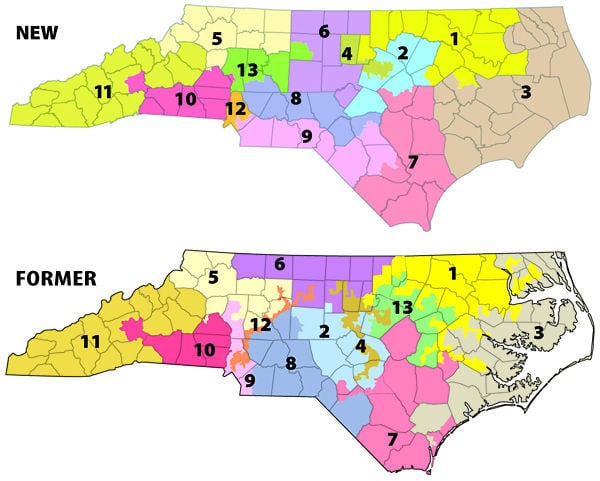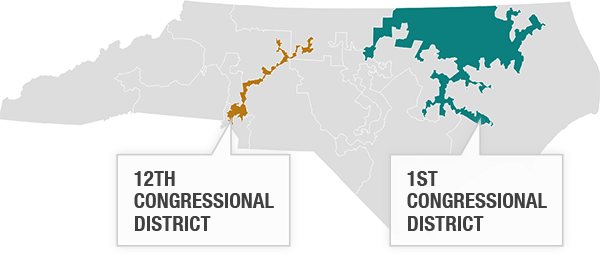According to most Americans’ idea of democracy, it follows that their vote should be treated as equal to everyone else’s vote. This is an almost necessary aspect of democracy: if this weren’t true, a system would arise in which one entity could exert power unto another (and keep that power). Those who are loyal to that entity/party would have more say in elections, and thus they could win more of the time. Now it is easy to say “this is just a hypothetical, one vote is one vote is one count, no vote is more important than another.” In the eyes of our federal presidential election, you could discount this by looking at populations of states vs. their respective delegate counts and say that those living in Wyoming have more voting power than those in say New York. This is a result of the electoral college, and is not something I will be looking at in this blog. However, elections in which citizens vote for a representative for their local physical area, their district per se, there arises a problem. How do we define and draw these districts? How should we group people into voting districts when it comes time to chose representatives?
It turns out that there are some rules when it comes to drawing district maps for States. Federally, there are two criteria for how congressional districts can be drawn per state:
- Each district must have an equal population (as close as possible, meaning there is not much room for flexibility)
- Each district must not have “lines that deny minority voters an equal opportunity to participate in the political process and to elect representatives of their choice.” This is very difficult to interpret and if you are interested you can read more about it in the first link below. Essentially, you cannot attempt to dilute a minority vote; a minority population must reasonably be able to exercise their power to have a say in the election. Districts can not be drawn so that these groups mathematically have no say due to the surrounding populations they are grouped with.
States also have their own rules for federal districts, and they choose the rules for their own state districts. Let’s take a look at North Carolina’s rules for federal congressional district drawing.
| State | Maintain Equal Population | Draw Compact Districts | Follow Political Boundaries | Preserve Communities of Interest |
Prohibit Undue Favoritism |
|---|
| North Carolina | Yes |
NC only legislates that congressional districts preserve equal population numbers. So, they only mandate the following of federal law. Interesting. Let’s look at a map of NC’s congressional districts and how it changed from 2012 to after 2014.

Let’s now highlight the former (2012-2014) map and it’s problems:

Courtesy of NPR
…. WTF?! Yes, those really are how the districts looked before the supreme court intervened. Specifically, the 12th and 1st districts were created to compact a massive amount of democratic votes into just two districts, meaning that while the republicans had just 49% of the vote, they got 10 out of the 13 votes. This is because the state legislature is allowed to draw the district maps with approval from the governor. Meaning, the republican state legislature, who had the power to make these maps, drew them in such a way that they federal republicans would keep power. While I do not go into the details of the state district maps, the same gerrymandering occurred, allowing the state legislatures to also retain their personal power.
Unfortunately, the following maps that were redrawn by republicans were found to gerrymander too, with the possibility that they were even MORE gerrymandered. And just recently, after being ordered by the state courts to draw maps again, they were found to gerrymander (less than before). These maps were allowed to stand in order to not delay the 2020 primary elections. This is the current NC Congressional District map:

While the state is about evenly split party wise, the republicans are expected to win 8 out of the 13 districts, which is still a sign of gerrymandering. As for the near future, maps will be completely redrawn for 2022 after the new census is recorded. The state is expected to get a 14th district.
The people deserve better. In a land where elections are touted as “free and fair,” we see that in North Carolina the elections are about anything but free and fair. Only non-partisan drawn districts would allow this to be true. Until we mandate maps to be drawn by non-partisan, transparent committees, gerrymandering will not go away. Some may argue that this is the biggest threat to our democracy (at least Brian Klaas at WaPo thinks so). Klaas points out that gerrymandering has led to a general sentiment that Americans don’t care about elections since they seem pre-determined. And in NC’s case, this is true. So why aren’t we protesting about it? Those with the power to stop gerrymandering would be working against their own interests in putting a stop to gerrymandering; their power is almost absolutely derived from gerrymandering’s implementation. Voting against them won’t help either, as they have clearly worked around that. Gerrymandering is a core threat to any social issue, since it undermines the entire process in which ideas supported by the people are put into legislation.
Maybe you, the reader, have a good idea about how to approach gerrymandering. Let me know in the comments.
Sources:
http://redistricting.lls.edu/where.php
http://redistricting.lls.edu/where-tablefed.php
https://www.greensboro.com/news/local_news/n-c-s-new-congressional-district-map-becomes-law/article_86ce3668-b5cf-55db-abb3-37399667262b.html
https://www.washingtonpost.com/news/wonk/wp/2016/10/28/how-to-gerrymander-your-way-to-a-huge-election-victory/
https://www.newsobserver.com/news/politics-government/election/article237958719.html
https://www.washingtonpost.com/news/democracy-post/wp/2017/02/10/gerrymandering-is-the-biggest-obstacle-to-genuine-democracy-in-the-united-states-so-why-is-no-one-protesting/
The issue of gerrymandering has been problematic in many states and is even more concerning considering that the 2020 elections are fast approaching. Both parties are guilty of trying to manipulate voting districts to ensure that their respective leaders will remain in power. This is very reflective of the theory that leaders’ main goal is to remain in power. One state that is particularly gerrymandered is Pennsylvania. It currently is gerrymandered in a way that benefits the Republican party. While I believe that gerrymandering on a whole is wrong, I am particularly concerned about it do to the presidential candidate that the Republican party is backing at the moment. I believe that while many people would agree that gerrymandering is not very democratic, it is a very difficult issue to solve. The main issue being that the change would either have to be made willingly by those in office (which is incredibly unlikely, as I stated about the theory) or that the courts order a change to happen. However, as you mentioned in your blog, the courts are not always a reliable source to fix undemocratic issues. This is particularly true now that the judges in courts are so divided along party lines. In courts where there is a Democratic majority, for example, and they are presented with a gerrymandering case that favors the Democratic party, they will not be inclined to vote against the case. In Pennsylvania, there has been a large, bipartisan movement, to end gerrymandering known as Fair Districts PA. Their goal is to get the PA legislature to pass a bill that would allow independent citizens to draw the districts. As of now, the bill has been introduced in the state House and Senate, but it is unlikely it will pass due to how divided the state government is.
Sources:
http://worldpopulationreview.com/states/most-gerrymandered-states/
https://www.inquirer.com/philly/news/politics/state/pennsylvania-gerrymandering-case-congressional-redistricting-map-coverage-guide-20180615.html
https://www.fairdistrictspa.com/the-problem/about-gerrymandering
This is extremely interesting! I have learned about Gerrymandering in the past but didn’t realize it was still such a current issue. It really seems that the republican legislature of North Carolina wanted to stay in power and therefore they drew lines for the districts that would help them win. It seems as though Gerrymandering can be tough to prove “biased” or “unfair” until after elections but I do think politicians should be spending more time to make sure these maps are fair for the people of the state. Luckily the next census will force North Carolina to clean everything up once more, hopefully making it a little more equal. According to The New York Times, Wisconsin is another state that has been having troubles with gerrymandering and there has been recent pressure from the citizens for state lawmakers or the supreme court to take action. https://www.nytimes.com/2019/08/15/us/gerrymandering-redistricting-wisconsin.html
It is likely that this is a country wide issue, and as you said, limits the level of true democracy that our nation was founded on. I believe the only way for this to be fixed is for district maps to be made by some independent source, possibly from an independent government organization, an organization run by citizens etc. Of course this will continue if governors have the ability to make the maps because they will always want to stay in power or at least have their party stay in power. It is interesting how racial and minority diversity plays a role in the creation of maps and how it must be carefully drawn in order to give everybody a fair chance for their voice to be heard through their vote. I would assume this would play a major role in how gerrymandering can be played in someone’s advantage, which is extremely unfortunate.
Your entire blog post on Gerrymandering is nothing short of superb! I love the insight that you granted us too. I personally believe that everything that you wrote about in this blog was well executed. I love all of the information, the graphs, pictures, and personal opinions. I gained so much knowledge from reading this. More people should write like you and also take the time to read your work on their own time! Keep up the good work!
https://en.m.wikipedia.org/wiki/Gerrymandering